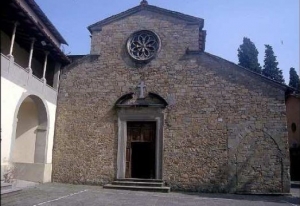
Information
Address:
Via Corsena 5, 55022 Bagni di Lucca (LU)
Foundation:
XI century
Telephone:
+39 0583 87346
District/Location:
Bagni di Lucca, Corsena
District:
Mediavalle


This church, one of the most interesting examples of medieval architecture in the Lucca area, has clear ties with the models of Arliano and Coreglia. In the early 20th century it underwent a process of "medievalization" to restore its original arrangement. The interior features important 17th century paintings by Giovan Domenico Ferrucci, Tiberio Franchi and Gaspare Mannucci.
Corsena
The Church of Corsena – original nucleus of the town now known as Bagni di Lucca – is first recorded in 1073, and in 1165 results as being officiated by the clergy who, according to the Gregorian reform, accepted the rule of communal living. A document from 1231 reveals that the members of the political association of the aristocracy of Porcari laid claims on it. In the "Estimo" of 1260 it results belonging to the Parish Church of Controne, from which it broke away in 1406; possibly because of the short proximity between them, this independence was hard fought and even from the start only granted in exchange for an assigning of assets to the mother church. In 1553 it formed part of the University of the Cappellani of the Cathedral and boasted no less than six altars, reduced to three in 1575, dedicated to the Saints Innocenzo, Caterina and Crucifix. The dedication and number of altars was changed again in 1711 (Madonna of the Rosary, Jesus, S. Antonio da Padova, Holy Virgin Mary and S. Pietro).
During the 16th century two active confraternities were founded – that of Our Lady of Perpetual Help or Suffrage and of the Holy Sacrament – which led to the building of two oratories adjacent to the church, still in existence today with their sumptuous interiors.
The building, whose façade was enlarged to include a 14th century arcade, lost its apsidal parte and bell tower, originally at the edge and now in front of the façade, with the restructuration in 1693 by the Marzetti family.
For that which remains of the original church of S. Pietro it proves to be one of the most interesting examples of medieval architecture in the Lucca area. Like other churches in the area, it has clear ties with the models of the parish church of Arliano and S. Martino of Coreglia. In particular, the small arches on the external side of the central nave are clearly akin to those in the same position at Arliano. In the early 20th century the church underwent a radical intervention to restore its old medieval forms that had been lost over time. The façade was re-designed by the painter Luigi Norfini from Pescia, and built on the original portico with the addition of a concrete rose window; the high-altar was created by Domenico Martini; and Michele Marcucci is responsible for the pictorial decorations. There is an interesting painting depicting the refurbishments carried out in the 17th century. Of particular interest: the Our Lady of the Holy Rosary by Giovan Domenico Ferrucci, the Saint Antonio da Padova by Tiberio Franchi and another Our Lady of the Holy Rosary by Gaspare Mannucci. There is also a mid-16th century shrine for the holy oils by the Civitali studio.
During the 16th century two active confraternities were founded – that of Our Lady of Perpetual Help or Suffrage and of the Holy Sacrament – which led to the building of two oratories adjacent to the church, still in existence today with their sumptuous interiors.
The building, whose façade was enlarged to include a 14th century arcade, lost its apsidal parte and bell tower, originally at the edge and now in front of the façade, with the restructuration in 1693 by the Marzetti family.
For that which remains of the original church of S. Pietro it proves to be one of the most interesting examples of medieval architecture in the Lucca area. Like other churches in the area, it has clear ties with the models of the parish church of Arliano and S. Martino of Coreglia. In particular, the small arches on the external side of the central nave are clearly akin to those in the same position at Arliano. In the early 20th century the church underwent a radical intervention to restore its old medieval forms that had been lost over time. The façade was re-designed by the painter Luigi Norfini from Pescia, and built on the original portico with the addition of a concrete rose window; the high-altar was created by Domenico Martini; and Michele Marcucci is responsible for the pictorial decorations. There is an interesting painting depicting the refurbishments carried out in the 17th century. Of particular interest: the Our Lady of the Holy Rosary by Giovan Domenico Ferrucci, the Saint Antonio da Padova by Tiberio Franchi and another Our Lady of the Holy Rosary by Gaspare Mannucci. There is also a mid-16th century shrine for the holy oils by the Civitali studio.
Scopri altre attrazioni vicino a Saint Peter
See allYou may also like..
See allFind more
0











